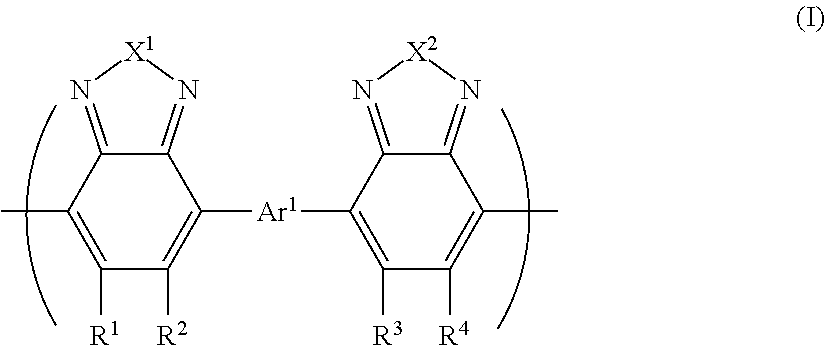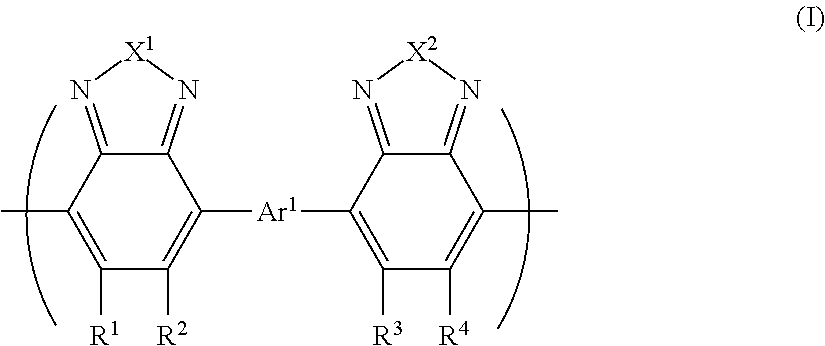Polymer compound and polymer light-emitting device using the same
- Summary
- Abstract
- Description
- Claims
- Application Information
AI Technical Summary
Benefits of technology
Problems solved by technology
Method used
Image
Examples
example 1
Synthesis of Compound M-1
[0263]A compound M-1 was synthesized by the following reaction.
[0264]Synthesis of Compound M-1-3
[0265]Under an inert atmosphere, into a 500 mL four-necked flask was charged a compound M-1-1 (13.46 g, 80 mmol) and 240 mL of tetrahydrofuran, and the mixture was cooled down to −78° C. using acetone / dry ice, and stirred. From a dropping funnel, a n-butyllithium 1.6M hexane solution (58 mL, 88 mmol) was added, and the mixture was stirred for 1 hour, then, a compound M-1-2 (44.36 g, 240 mmol) was added and stirring of the mixture was continued at −78° C. for 2 hours. Thereafter, water was added, and the tetrahydrofuran solution was concentrated, then, extracted with toluene. The extract was dried over magnesium sulfate, then, filtrated and concentrated, then, subjected to purification by a silica gel column, to obtain a compound M-1-3 (18.05 g, yield: 71%). The above-described operation was repeated twice.
[0266]Synthesis of Compound M-1-5
[0267]Under an inert atmos...
example 2
Synthesis of Polymer Compound P-1
[0272]Synthesis of Compound M-2
[0273]A compound M-2 was synthesized by a method described in Japanese Patent Application National Publication (Laid-Open) No. 2004-534863. That is, 4,7-bis(5-bromo-4-hexylthiophen-2-yl)-2,1,3-benzothiadiazole and 2-(tributylstannyl)thiophene were dissolved in toluene, and reacted for 18 hours while heating under reflux in the presence of tetrakis(triphenylphosphine)palladium. The reaction product was cooled down to room temperature, and filtrated through silica gel. The filtrate was concentrated and re-crystallized from hexane. The re-crystallized body was dissolved in dimethylformamide (hereinafter, referred to as “DMF”), further, a DMF solution of N-bromosuccinimide was dropped, and the mixture was stirred at room temperature overnight. The product was filtrated, and washed with methanol and deionized water. Re-crystallization from hexane was performed to obtain a compound M-2.
[0274]Synthesis of Polymer Compound P-1
[...
synthesis example 1
Synthesis of Polymer Compound P-3
[0279]Under an inert atmosphere, 2,7-bis(1,3,2-dioxaborolan-2-yl)-9,9-dioctylfluorene (5.20 g), bis(4-bromophenyl)-(4-sec-butylphenyl)-amine (4.50 g), palladium acetate (2.2 mg), tri(2-methylphenyl)phosphine (15.1 mg), trioctylmethyl ammonium chloride (trade name: Aliquat (registered trademark) 336, 0.91 g, manufactured by Aldrich) and toluene (70 ml) were mixed, and heated at 105° C. Into this reaction solution was dropped a 2M sodium carbonate aqueous solution (19 ml), and the mixture was refluxed for 4 hours. After the reaction, phenylboronic acid (121 mg) was added, and the mixture was further refluxed for 3 hours. Then, a sodium diethyldithiacarbamate aqueous solution was added and the mixture was stirred at 80° C. for 4 hours. After cooling, the mixture was washed with water (60 ml) three times, with a 3 wt % acetic acid aqueous solution (60 ml) three times and with water (60 ml) three times, and purified by passing through an alumina column an...
PUM
| Property | Measurement | Unit |
|---|---|---|
| Molecular weight | aaaaa | aaaaa |
Abstract
Description
Claims
Application Information
 Login to View More
Login to View More - R&D
- Intellectual Property
- Life Sciences
- Materials
- Tech Scout
- Unparalleled Data Quality
- Higher Quality Content
- 60% Fewer Hallucinations
Browse by: Latest US Patents, China's latest patents, Technical Efficacy Thesaurus, Application Domain, Technology Topic, Popular Technical Reports.
© 2025 PatSnap. All rights reserved.Legal|Privacy policy|Modern Slavery Act Transparency Statement|Sitemap|About US| Contact US: help@patsnap.com



